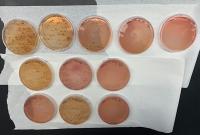Prevalence of Antibiotic Resistance in the Environment (PARE)
Common infections are becoming hard to treat due to the increase in antibiotic-resistant strains of bacteria. Antibiotics are over-prescribed for human illnesses and administered to livestock to promote health and growth of animals. Once ingested, they are excreted and end up in sewage systems and in the environment. Very little is known about how the presence of antibiotics in the environment affects the prevalence of antibiotic-resistant bacteria in the environment. The Prevalence of Antibiotic Resistance in the Environment (PARE) project is harnessing the work of students in a nationwide experiment to track and report antibiotic resistant bacteria in the soil and compile the data in the PARE Global database. Developed by Carol Bacsom-Slack, the PARE CURE has been implemented at many different types of institutions in over 30 states (Genné-Bacon & Bascom-Slack, 2018)
PARE is a CURE for students enrolled in non-majors Bio1110 and majors Bio1113 and Bio1113H courses. Students are given a unique chance to conduct authentic research and learn a variety of laboratory techniques and professional skills. They are using scientific processes to determine if the bacteria they’ve found in the environment are resistant to antibiotics. Students learn microbiology plating techniques, conduct bacterial colony counting, and practice molecular biology techniques such as DNA extraction, PCR, gel electrophoresis and bioinformatics analysis. Students analyze and interpret their results as well as read and discuss primary literature sources. Finally, their results are included in the national PARE database.

Plates from a PARE experiment
Dr. Jennifer Larson started this project in 2016 and since then every semester multiple CLSE instructors guided by Dr. Lubomira Cubonova have implemented PARE in their courses. As of now, the database contains 85 clean and statistically valid entries of the relative frequencies of antibiotic resistant microbes reported by our OSU students. As in any authentic research, this laboratory study can be “messy,” but students appreciate the notion of ownership of the project. They choose their own soil sample locations, such as their hometowns or even their family backyards. They analyze their own data and they share their experiences and knowledge in the classroom setting as well as in departmental poster presentation sessions.
